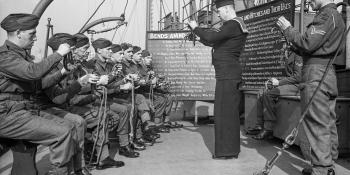WEAPONS OF WAR
Have you spotted the innocuous shrouds on tank guns and wondered what they’re for? Ed Webster profiles a significant British invention inspired by Canadians caught in the rain!
It was a cool, cloudy afternoon on a firing range in 1945. Engineers and soldiers of the Canadian Armament Research and Development Establishment (CARDE) were testing a new armour-piercing discarding sabot (APDS) round designed for the QF 17-pounder antitank gun. After a morning of successful firing, they took a break to escape the cold and avoid the rain that had begun to fall. After a quick brew, they returned to their guns, but something was wrong. None of their shots were on target, yet seemingly nothing had changed with the weapon nor the ammunition. They began to look for other causes, but little did they know that their findings would forever change how tanks fight.
Prior to rain stopping play, the shots had been placed accurately in a tight grouping.
However, after the break, the
“To even trained eyes it would be barely noticeable – but such deviation would produce a 6½ft error at 1,000 yards”
rounds formed two distinct groups with the mean point of impact (MPI) separated by eight minutes of arc (arcmi…




